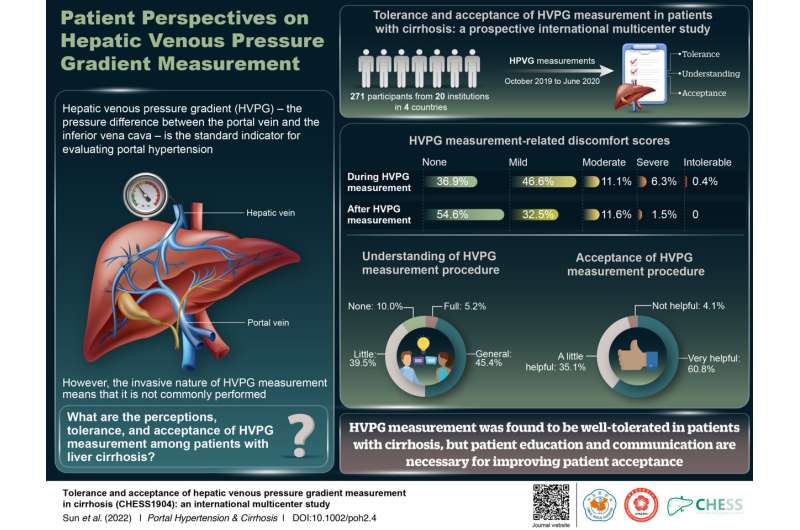Study recommends that liver cirrhosis patients be educated on hepatic venous pressure gradient procedure

Just like the hypertension that people develop when their blood pressure increases, the increase of blood pressure in the main vein that supplies blood to the liver, called the portal vein, is also a dangerous situation. This condition, called portal hypertension, is the main side effect of liver cirrhosis, and the development of complications like ascites, hepatic encephalopathy and variceal hemorrhage are dependent on the severity of this hypertension. Recording portal hypertension is therefore crucial when studying the effect of drugs used to treat cirrhosis and for predicting patient prognosis.
Hepatic venous pressure gradient (HVPG) represents the difference between pressures in the portal vein and the intra-abdominal portion of inferior vena cava, another major vein, and is the standard procedure used to assess portal hypertension. However, unlike overall blood pressure, this method is invasive, because the vein is located deep in the body. Therefore, it isn't performed commonly, so patients for whom this method is recommended might not know much about it.
Patient tolerance and acceptance are important if medical techniques are to be used more widely. But the tolerance and acceptance of patients with liver cirrhosis hasn't been studied. So, a team of researchers led by Dr. Xiaolong Qi of The First Hospital of Lanzhou University, China, has addressed this gap in their latest study, published in Portal Hypertension & Cirrhosis. The team conducted a prospective international study among 271 patients with liver cirrhosis. Data related to tolerance and acceptance was assessed by using questionnaires.
The team found that over 80% of patients had no or mild discomfort either during the procedure or after it. Almost 50% of patients had little to no understanding of the value of HVPG measurement and around 39% of patients regarded HVPG measurements of being little to no help. Only 15% of patients reported that they would definitely undergo the procedure again with the rest of the patients reporting that they weren't too sure about it; 63% of patients found the cost of the procedure to be acceptable.
So, what do these results signify? Dr. Qi states, "The results of our study indicate that HVPG was found to be tolerated well in patients with cirrhosis. But we expected a much higher rate of acceptance among patients. Half the patients did not understand the value of the procedure, suggesting that the communication between doctors and patients was insufficient. If patients don't have the right information and knowledge about a procedure, they're less likely to choose it. Clinicians should make it a priority to properly educate and guide patients in understanding the value of HVPG measurements."
This study highlights the need for patient education and awareness about this procedure in order to improve its overall acceptance. This is important, because the use of this procedure can help in achieving early diagnosis and improving patient outcomes in patients with cirrhosis. "We hope that our study will pave the way for this procedure to be widely accepted by the general public and medical community," concludes Dr. Qi.
More information: Jun‐Hui Sun et al, Tolerance and acceptance of hepatic venous pressure gradient measurement in cirrhosis (CHESS1904): An international multicenter study, Portal Hypertension & Cirrhosis (2022). DOI: 10.1002/poh2.4


















